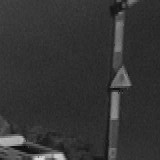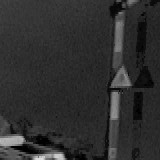Crosstalk cancellation


Team: B. Lacotte, J. Konrad, E. Dubois (University of Ottawa)
Funding: Natural Sciences and Engineering Research Council (NSERC), Canada
Status: Completed (1998-2000)
Background: Stereoscopic visualization systems using liquid crystal shutter (LCS) eyewear provide today the best overall quality of 3-D images and therefore have a dominant position in commercial as well as professional markets. Due to the LCS and screen characteristics, however, such systems suffer from perceptual crosstalk (ghosting) at object boundaries that can reduce, and at times inhibit, the ability to perceive depth. A reduction of this crosstalk is essential if LCS-based 3-D displays are to be widely adopted.
Summary: We have developed a method to reduce the perceived stereoscopic crosstalk by creating “anti-crosstalk” (reduced image intensity) in affected areas of the original images. When the modified images are displayed, the unintended light from the other view increases the intensity to the expected level. The method is based on a simple model of intensity leak whose parameters we estimated in a series of subjective experiments. Based on this model, we developed a computationally-efficient, low-memory algorithm to create the “anti-crosstalk”. Since full crosstalk elimination implies an unacceptable image degradation (reduced contrast), we studied the trade-off between crosstalk elimination and image contrast (see below). The viewer response was very positive; 3-D perception of many objects became either much easier or even effortless. Since the proposed algorithm can be implemented in real time (linear scaling and table look-up), it can be embedded into today’s 3-D screens at minimal cost.
Crosstalk functions
Look-up tables
Results: In order to accurately characterize the crosstalk model, we have performed a series of psychovisual measurements of crosstalk functions “phi_R”, “phi_G” and “phi_B”. You can download an archive with all three functions from the call-out box on right. After decompression, each file will contain numerical values of the corresponding crosstalk function evaluated over a 7×6 grid. The values are averages of measurements for 3 subjects and include bilinearly-extrapolated values at level 255 for both intended and unintended stimuli; the resulting grid size is 8×7. The files have been produced by Matlab’s “save -ascii” function. Each row corresponds to one value of the intended stimulus (in the order: 0, 25, 50, 75, 100, 150, 235, 255) while each column corresponds to one value of the unintended stimulus (in the order: 30, 60, 95, 135, 185, 235, 255).
Manege
Piano
Street Organ
Train
Tunnel
Based on the crosstalk functions we iteratively computed 6 look-up tables “gamma_l” and “gamma_r” for R, G and B components. We rounded the final values to integers in [0,255] range (human visual system cannot discern small intensity differences). The 6 tables can be downloaded as archive from the call-out box on right. After decompression, each .dat file will contain a table produced by Matlab’s “save -ascii” function. Each row corresponds to one value of a pixel from the left image (from 0 to 255) while each column corresponds to the value of the corresponding pixel in the right image (from 0 to 255). Since no values below zero are allowed, the tables can be used directly to implement crosstalk cancellation based on the non-negativity constraint (no pre-processing). In this case, for example, to cancel the crosstalk in the left image for R, a suitable entry in the table “R (red) left” must be found; pixel value from the left image defines the row number whereas the value from the right image defines the column number.
Publications:
- J. Konrad, B. Lacotte, and E. Dubois, “Cancellation of image crosstalk in time-sequential displays of stereoscopic video,” IEEE Trans. Image Process., vol. 9, pp. 897-908, May 2000, [experimental results].